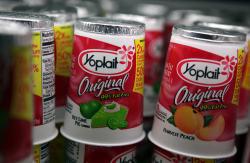A reader recently asked the Food Explainer, “what precisely defines ‘yogurt’ for the FDA”? As you may have noticed, next to the yogurts in the dairy aisle is a product labeled “cultured dairy blend,” which looks like yogurt and tastes like yogurt. What’s the distinction, then, and is there more or less beneficial bacteria in yogurt than in the dairy blend doppelganger?
At its most basic, yogurt is a dairy product fermented by starter cultures (basically lactic-acid-producing bacteria). These cultures convert lactose—the sugar portion of milk—to acid. The drop in pH in turn causes the milk’s proteins to set, so the liquid thickens into yogurt.
To ensure consistency, however, the FDA has established much more extensive criteria listed in what’s called a “standard of identity.” If a product doesn’t meet these exacting conditions, even if it appears yogurt-like, it can’t legally be called yogurt—so marketers came up with the phrase “cultured dairy blend” to apply to similar products. There’s no FDA standard for products labeled with this phrase, so manufacturers have considerably more leeway with production methods and ingredients.
What exactly is yogurt to the FDA? It must be produced by fermenting cream, milk, partially skimmed milk, or skimmed milk, either alone or in combination. A second set of optional dairy ingredients may be added. These include nonfat dry milk, buttermilk, whey, and lactose. If vitamins A and/or D are added, they have to be present in certain quantities. Yogurt can include a permitted list of sweeteners as well as flavoring ingredients, color additives, and stabilizers.
The FDA regulates yogurt’s composition, too. Before flavorings are thrown into the mix, the mixture must be at least 3.25 percent milkfat and at least 8.25 percent non-fat milk solids. A specific ratio of proteins to milk solids must also be maintained.
The type of starter culture used in yogurt’s fermentation process is also vital. The culture must contain two specific types of lactic-acid-producing bacteria: Lactobacillus bulgaricus and Streptococcus thermophilus. These bacterial cultures were selected by the FDA because they work especially well in tandem, each one producing compounds that enhance and speed up the productivity of the other. The federal regulations also stipulate that yogurt must contain a certain minimum amount of lactic acid.
Yogurt might also contain other live bacteria, such as probiotics, microorganisms that have been found, through clinical studies, to confer a specific health benefit. Probiotics are added purely because they are supposed to promote digestive well-being and not because they play a role in fermentation. However, yogurt doesn’t have to contain these additional beneficial bacteria—while yogurt must be bacterially fermented, the end product doesn’t legally have to contain any bacteria at all. (Some yogurts are heat-treated to extend their shelf life, a process that kills all the starter cultures.) There are no federal regulations governing the amount or quality of live cultures in yogurts.
So what makes “cultured dairy blends” different? These blends, like Kroger’s CARBmaster, are low-sugar, high-protein alternatives to conventional yogurt, and they’re suitable for diabetics, people who are lactose intolerant, and anyone watching their calories and carbs. Manufacturers lower the carbohydrate content in cultured dairy blends by using so-called fractionated milk products, such as milk protein concentrate, in which the protein percentage of milk has been increased and the sugar portion filtered out. Since such fractionated milk products aren’t permitted in the standard of identity for yogurt—in part because they affect the milk-solid-to-protein ratio—blends that contain them can’t be labeled “yogurt.”
However, cultured dairy blends, like yogurt, are also fermented by bacterial cultures. The only difference is that the starter culture might not contain the same two starter bacteria the FDA stipulates for yogurt. The nutrition label on CARBmaster says it’s made with active starter cultures without specifying which ones. Since different starter cultures produce different types and/or varying quantities of acid during fermentation, the cultured dairy blend might not have the same acid profile as yogurt.
In addition to starter cultures used for fermentation, CARBmaster cultured dairy blend contains two common probiotics, Lactobacillus acidophilus and Bifidobacterium bifidum, which are added specifically to help maintain a healthy gut environment and aid digestion.
Since yogurt might not contain any beneficial bacteria (depending on whether it’s heat-treated), while cultured dairy blends might indeed contain probiotics, what’s a probiotic-seeker to do? Look for the National Yogurt Association (NYA) seal. To qualify, at the time of manufacture, a yogurt or cultured dairy product must contain at least 100 million bacteria per gram, since live and active cultures are only effective if they are consumed in such large numbers. Keep one thing in mind, though: While cultured dairy products sit on refrigerated shelves, the number of beneficial bacteria will become depleted as microorganisms die or become inactive. To maximize the amount of live bacteria you ingest, try to eat the yogurt or cultured dairy blend soon after purchase, and certainly before the sell-by date.
Food Explainer thanks Bob Roberts of the College of Agricultural Sciences at Pennsylvania State University, Phillip Tong of the Dairy Products Technology Center at California Polytechnic State University, and John A. Lucey of the Wisconsin Center for Dairy Research.
Have a question about something you’re eating or drinking? Send it to slatefoodexplainer@gmail.com.
Previously from the Food Explainer:
Why Does Tomato Sauce Splatter When It Cooks?
Why Does Steam Make Bread Light and Crusty?
Why Does Eating Hot Chilies Make My Nose Run?
Why Are Some Boiled Eggs Easier To Peel Than Others?
Why Does Fish Sauce Have an Expiration Date?
Why Is Cheese Yellow When Milk Is White?
